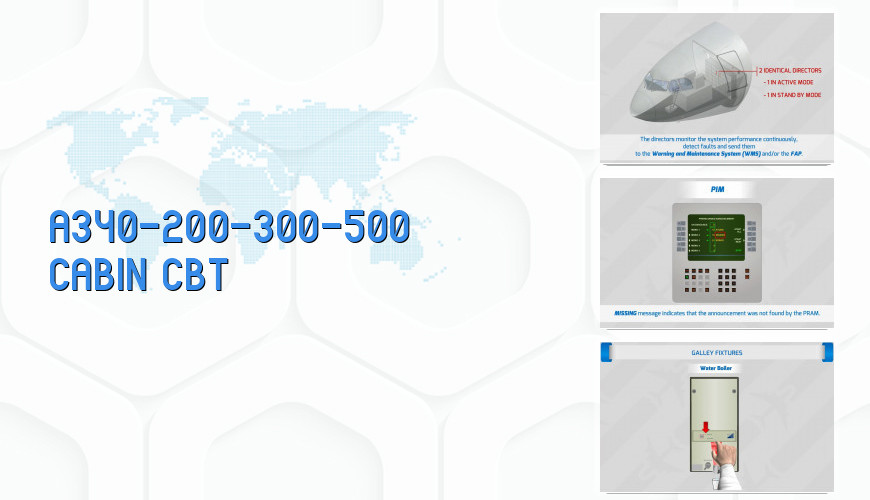
Course Information
A340-200-300-500 CABIN CBT
Content of the Course
| Slide | 198 | Duration | 02:00:10 | Exam | Yes |
|---|
- COURSE START
- INTRODUCTION
- AIRCRAFT GENERAL – A 340-200 Aircraft Descriptions and Principle Dimensions
- A 340-300 Aircraft Descriptions and Principle Dimensions
- A 340-500 Aircraft Descriptions and Principle Dimensions
- FLIGHT CONTROL SURFACES
- LANDING GEARS
- FUEL TANKS
- CARGO COMPARTMENTS
- ELECTRICAL POWER SOURCES – Auxiliary Power Unit (APU)
- Medical Panels
- AIR CONDITIONING AND PRESSURIZATION
- CABIN DOORS
- Escape Slides / Slide Rafts
- Type A Door – Preflight Check
- TYPE I EMERGENCY EXIT DOORS (3L/R)
- Type 1 Door – Preflight Check
- SLIDE ARMING / DISARMING OPERATION – TYPE A DOORS – ARMING OPERATION
- TYPE A DOORS – DISARMING OPERATION
- TYPE 1 DOORS – ARMING OPERATION
- TYPE 1 DOORS – DISARMING OPERATION
- NORMAL DOOR OPERATION – Type A Doors – Normal Door Opening – Inside Operation
- Type A Doors – Normal Door Closing – Inside Operation
- Type 1 Doors – Normal Door Opening – Inside Operation
- Type 1 Doors – Normal Door Closing – Inside Operation
- Normal Door Opening – Outside
- Normal Door Closing – Outside
- CABIN LAYOUT
- PASSENGER CABIN – Passenger Seats
- Passenger Service Units
- Overhead Stowage Compartments
- Baby Bassinets
- IN-FLIGHT ENTERTAINMENT SYSTEM (IFE)
- Audio Video on Demand (AVOD)
- Passenger Control Units (PCU)
- VCC Smoke Detection
- VCC Smoke Detector Pre-flight Check
- CABIN ATTENDANT STATIONS
- CABIN CONTROLS AND INDICATION SYSTEMS – CIDS – Cabin Intercommunication Data System
- Electronic Centralized Aircraft Monitor (ECAM)
- FAP – Forward Attendant Panel
- System Failure Messages
- CIDS Internal Failure Messages
- Vacuum Lavatories Failure Messages
- Additional Attendant Panel (AAP)
- Attendant Indication Panel (AIP)
- Area Call Panel (ACP)
- EMERGENCY EVACUATION SIGNALING (EVAC)
- EMERGENCY LIGHTING SYSTEM
- INTERCOMMUNICATION SYSTEM
- Interphone System
- Calls from the Cockpit
- Cockpit to All Attendant Calls
- Cockpit to Purser Calls
- Cockpit to Attendant Calls
- Cockpit to Crew Rest Compartments
- Emergency Call from the Cockpit
- Calls from the Cabin – Cabin to Cockpit Calls
- Cabin to Cabin Calls
- Cabin to All Attendant Call
- Emergency Calls Initiated from the Purser or Attendant Stations
- Ending Interphone Calls
- Priorities of the Interphone Calls
- Passenger Address (PA) System
- Priorities of the PA Announcements
- Reset of PA Functions
- Passenger Call System
- Reset of Passenger Calls
- Passenger Lighted Signs
- WATER AND WASTE SYSTEM
- LAVATORIES
- Lavatory Lighting
- Lavatory Water Heater
- Lavatory Manual Water Shut Off Valve
- Lavatory Drain Assembly
- Lavatory Drain Valve
- Lavatory Fire Extinguisher
- Lavatory Smoke Detector
- GALLEYS
- Galley Fixtures – Coffee Maker
- Espresso Maker
- Water Boiler
- Wine Chiller
- Trash Compactors
- Trash Compactor Fire
- CREW REST COMPARTMENTS
- Flight Crew Rest Compartment (FCRC)
- FCRC Emergency Equipment
- Lower Deck Mobile Crew Rest (LD-MCR)
- LD-MCR Entrance Door
- LD-MCR Entrance Hatch
- LD-MCR Emergency Equipment
- LD-MCR Communication System
- LD-MCR Air Conditioning
- LD-MCR Temperature Control
- LD-MCR Lighting
- LD-MCR Emergency Evacuation
- LD-MCR Smoke Detection System
- LD-MCR Fire Fighting Procedure
- LD-MCR Decompression Procedure
- Evacuating an Incapacitated Person out of the LD-MCR
- AIRCRAFT OXYGEN SYSTEM
- Cabin Fixed Oxygen System
- Cockpit fixed oxygen system
- Portable Oxygen System
- COCKPIT
- Cockpit Door
- Normal Entry to Cockpit
- Emergency Access to Cockpit
- Manual Door Locking System
- Cockpit Evacuation – To open the Cockpit Sliding Windows
- To use cockpit sliding windows for evacuation
- Avionics Compartment Hatch
- To open the Avionics Compartment Hatch
- EVACUATION PROCEDURES AND CROWD CONTROL
- Cabin Crew Assigned Areas for Evacuation
- Emergency Door Opening / On Ground
- Emergency Door Opening / Ditching
- CARRYING SLIDE PACK TO AN ALTERNATE DOOR
- NORMAL AND EMERGENCY SEATING POSITIONS – OF CABIN ATTENDANTS
- SEATING POSITIONS OF ABLE BODIED PERSONS (ABPs)
- LEAST RISK BOMB LOCATION (LRBL)
- EMERGENCY EQUIPMENT
- COURSE END
